 Why do some knives become fads? There are plenty of reasons. The Rambo movies made hollow-handle survival knives all the rage back in the 1980s. Theorizing over a lockback stiletto supposedly purchased by OJ Simpsons made that knife a best-seller during the publicity surrounding Simpson’s murder trial. Any and all forms of “tactical folder” swept the industry after Spyderco introduced the pocket clip and thumbhole opener — but this last is not a fad. (The thumb hole is, in fact, an industry trend.)
Why do some knives become fads? There are plenty of reasons. The Rambo movies made hollow-handle survival knives all the rage back in the 1980s. Theorizing over a lockback stiletto supposedly purchased by OJ Simpsons made that knife a best-seller during the publicity surrounding Simpson’s murder trial. Any and all forms of “tactical folder” swept the industry after Spyderco introduced the pocket clip and thumbhole opener — but this last is not a fad. (The thumb hole is, in fact, an industry trend.)
At what point does a fad become a trend? We can’t usually say until after the fact. It’s true, though, that as of this writing the Indonesian kerambit (characterized by a finger hole at the end of the grip and most often possessing a hawbill blade) remains quite popular in the knife industry, after a period of “fad” popularity during which many manufacturers introduced their own such models. Even the reluctant Lynn Thompson of Cold Steel, who trashed the popularity of the knife during the height of the blade’s newfound popularity, eventually gave in and started marketing some kerambit patterns of his own.
Other prominent manufacturers who have or who still do offer kerambits include Richard Derespina, Steve Tarani (who has written books on knife fighting and on the kerambit specifically), Ernest Emerson, and Sal Glesser of Spyderco. Countless others have gotten into the act, too, and inexpensive kerambits made in China for Mtech, Master Cutlery, RAM Instrument, and others are everywhere.
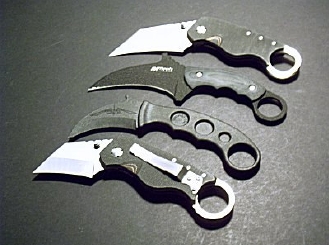 Emerson and Tarani have written articles publicly in which they tout the benefits of the kerambit. In 2003, Lynn Thompson published an editorial in the Cold Steel catalog’s Riposte column in which he characterized the kerambit as “an obscure knife from Indonesia… being pawn[ed] off” on an “unsuspecting public” with the help of Blade magazine (a publication with whom Thompson has had differences in the past). Thompson also correctly pointed out that the kerambit is small, concealable, allows for powerful slashes and stabs at close range, and is difficult to contend with when attempting a disarm. He went on to criticize its inherently weak extended grip and the relatively short reach of the reverse grip using this knife.
Emerson and Tarani have written articles publicly in which they tout the benefits of the kerambit. In 2003, Lynn Thompson published an editorial in the Cold Steel catalog’s Riposte column in which he characterized the kerambit as “an obscure knife from Indonesia… being pawn[ed] off” on an “unsuspecting public” with the help of Blade magazine (a publication with whom Thompson has had differences in the past). Thompson also correctly pointed out that the kerambit is small, concealable, allows for powerful slashes and stabs at close range, and is difficult to contend with when attempting a disarm. He went on to criticize its inherently weak extended grip and the relatively short reach of the reverse grip using this knife.
Thompson’s Warrior’s Edge system is based on “long range knife fighting,” and therefore biased towards large knives. While I can see where’s coming from, range is not something one can effectively control when fighting with blades. Anyone familiar with practical knife “fighting” knows that, in real sparring, the size of the knife and the exact grip used are far less important than body mechanics, footwork, and the positioning of the shoulders (and therefore your limbs) relative to these. Any “reach advantage” of a knife is a minor factor compared to body mechanics alone.
This debate aside, why would you choose a kerambit (also commonly spelled, “karambit”) over one of the other knife designs available? I think choosing any knife involves making a style choice as much as a utility choice. If you are drawn to the kerambit (which I’ll grant is a very intimidating, flashy blade at first blush), it is because you like it’s style, first and foremost.
The kerambit’s image will work against you legally in self-defense. If you choose to use it in that way, you will be cast as a vicious knife-fighter wannabe. As in all use-of-force issues, however, the context of your actions will matter far more than the aesthetics of the knife itself. Ignore image, and there are indeed physical advantages to the kerambit, at least for self-defense (and perhaps even for utility).
Because the kerambit is designed to be used in the reverse grip when used martially, it lends itself well to vicious, firmly rooted cutting attacks and hooking thrusts that closely resemble arm movements you’ll already find familiar. In Jurassic Park, when Sam Neil describes the velociraptor’s talon, he holds a fossilized claw in his hand in much the same way as one holds a kerambit. The talon, extended from the bottom of your fist, rips through whatever the hand passes.
The finger ring of the kerambit acts to stablize the knife, giving you good control over the blade and making it very hard for the knife to be dislodged from your grip. It also facilitates a very positive draw (if the knife is drawn into the reverse grip as it should be).
Some kerambit models on the market, especially inexpensive models, place the clip in the same orientation as would be found on a more conventional folding knife. This puts the clip on exactly the wrong end of the blade for draw into a reverse grip — if you are right-handed. If you’re a southpaw, the clip orientation is perfect out of the box.
Is the kerambit useful as a daily utility knife? It’s as useful as any hawkbill blade, really. It cuts well when sharp, has great “inverse belly,” if you want to call it that, to draw material through the cutting edge, and it could be used for horticulture and for cutting linoleum (activities for which hawkbill blades are traditionally used). There’s nothing you can do with a more conventional knife that you can’t do with a kerambit, unless the curved blade is not suited to work requiring a very long, straight edge.
The extended grip is more problematic. The applications of this method are limited; it is useful for momentary slashing and slicing maneuvers. It is, as has been observed by many, neither strong nor easily retained. I don’t see any need to bother with extended-grip techniques, but of course there’s really no reason to discourage you from learning them, either.
What I will discourage you from doing is spinning your kerambit. This is an epidemic among knife people, or at least it was when the kerambit first became popular. Inner-wrist and inner-forearm injuries are only too common when one starts spinning the kerambit on its finger ring. If you must spin the knife, wear an appropriate leather wrist cuff. The dexterity developed through such “knifesturbation” is probably of benefit, but please do consider the risks of monkeying about in this way.
The kerambit is a flash, lethal-looking tool that is useful for close-range fighting. It is, in fact, very powerful in that role. It is not the best choice for daily carry if you’re worried about being politically correct, but it certainly has style. If you do choose it, be mindful of its strengths and its weaknesses.
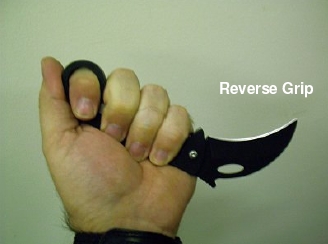
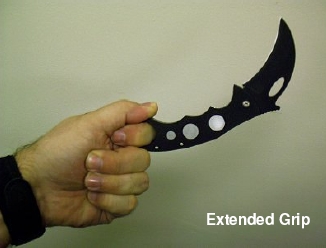
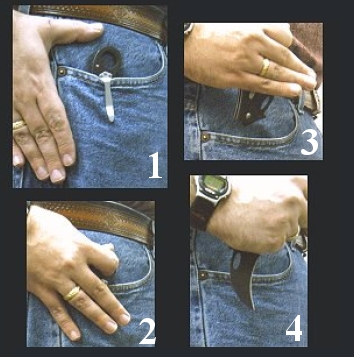
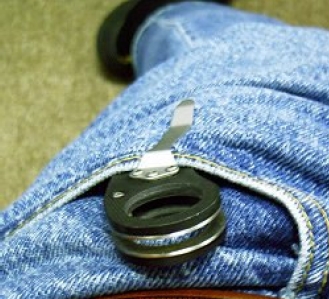
Just a few things to mention about this style of knife. while a straight edge knife is good you actually get more surface contact with a kerambit. Like most curved blades, they are designed for rounded body parts. Hamstring, bicep, throat, belly etc.
As a knife guy, it’s not unusual for me to carry up to 3 blades but normally 2.
A Balisong in a holster on my belt at the small of my back, a Spydeco Civilian clipped in one pocket and a S&W kerambit clipped in another pocket.
As with guns they serve different purposes and different functions and do different jobs. To open a box or slice open the brachial artery.
The kerambit in my opinion is the most lethal close combat weapon there is baring none. It beats any strait blade in all aspects of the fight. A very fast arcing swing with the blade pointing towards the enemy will no doubt penetrate/puncture and eventually slice most things on the front of a human. That includes most shirts and even denim..Been there and done that. It is also very good as a general use blade. My issue is, what would you say is the best model to buy for general carry, and what kind of price should I pay. Thanks for the info.
Peter
By “been there and done that,” are you saying you’ve carved up people with a kerambit? Because if that’s the case I’d say you should carry whatever that one was.
I don’t think the make or model of the knife matters as long as the handle is comfortable, you can maneuver the weapon without difficulty, and the sheath system (if applicable) is functional and practical. These qualities aren’t easy to find all in one place, when you come right down to it. One of the best kerambits I’ve found is a twenty-dollar fixed blade made in China that I got at my local outlet — it isn’t fancy and it’s a no-name brand, but it’s simple enough to work and has a basic Kydex sheath.
If you buy a folding kerambit, make sure the lock is strong and functions reliably. Keep an eye out for pocket clip orientation, as many folding kerambits on the market aren’t configured for a proper reverse grip draw.
While I like the korambit/kerambit design in general very much, I’d like to say it is a good idea to be careful which one you buy. A poorly made one can end up causing you harm, especially if you put your pinky finger in the loop, as illustrated in the photos. Imagine if the loop snapped, and shards of jagged steel were stuck in your finger? A design can be very appealing, but always be sure your blade comes from a reliable source, and is made reliably. I’d go ‘cheap’ on many purchases, but I tend to avoid cheap weapons. Too many of them are junk. Not just junk, but junk as dangerous to you as to an adversary.
None of the pictures in this article depict a pinky finger in the index finger loop.
Sorry. Didn’t mean to imply any did, but did mean to graphically illustrate what can easily happen with a junk-grade kerambit. Always make sure to get the best weapon you can afford.
Excellent post.
What is the model shown in the pocket pictures? And the four shown above those?
They’re all inexpensive knockoffs.
After searching for some time, I can’t find an inexpensive one configured for tip-down, reverse-grip carry, such as the foremost one in the picture.
I know you mentioned that they’re all inexpensive knockoffs, but is there any way you could direct me towards that one?
Or a similarly configured one, with either assisted opening, “flipper”, or thumbhole?
Well, you’ve got a few choices. You can take one of the cheap ones, remove the clip, and JB-weld it on the other side, but that tends to be a temporary fix only, as the JB-weld doesn’t hold for long. (I’ve tried that several times.) Basically if you want a decent-quality kerambit whose clip can be set up properly, your choices are a 5.11 Tarani Cub, one of the Fox G10 kerambits, the newest Spyderco kerambit (which has a wave feature on it if I remember correctly), or the Emerson kerambit (the best option, but the most expensive). The Fox tends to run about half the cost of the Emerson, again if I recall correctly and depending on where you buy. The 5.11 Tarani Cub is decently affordable, but lacks a means of opening the blade with one hand in the reverse grip (the Fox, Emerson, and Spyderco have Waves). I actually had one of my Tarani Cubs ground down to put a Wave-style hook on the blade, reducing its profile to a kind of exaggerated talon.
Your only other cheap-as-dirt option would be a counterfeit Emerson, which I can’t recommend, as you never know when the lock will fail (much less the moral issues involved). Let me know if I can be of further assistance.